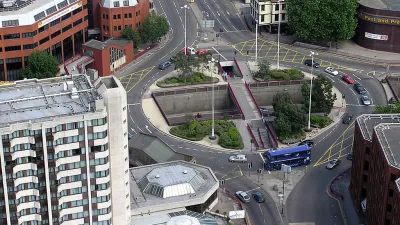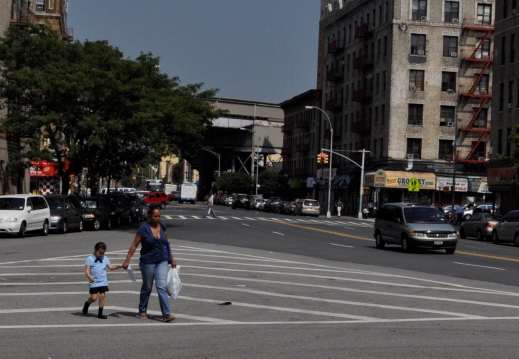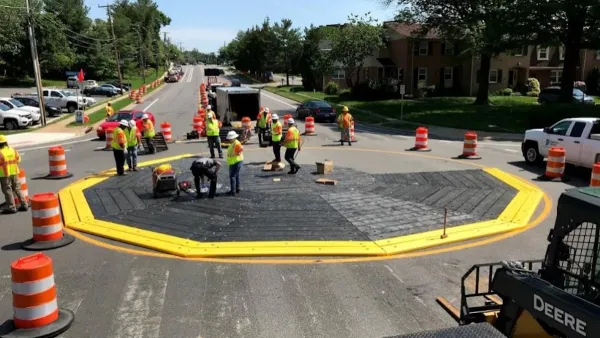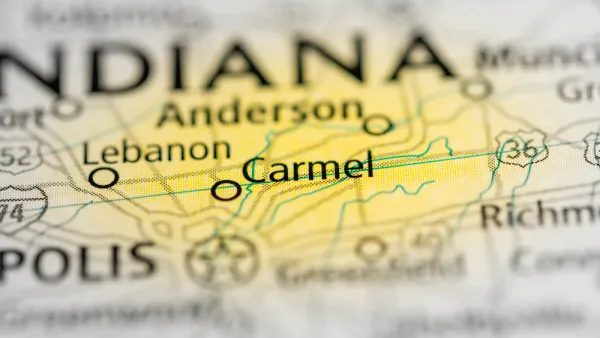Roundabouts, not to be confused with traffic circles, are becoming popular throughout the United States. The Bronx will get the first one in NYC. The insurance industry and FHWA consider them far safer than traffic lights and stop signs.

"Once seen only in countries like France and Britain, the roundabout, favored by traffic engineers because it cuts congestion and reduces collisions and deaths, is experiencing rapid growth in the United States," writes technology reporter Eric Taub. New York State has gone from 18 in 2005 to 112 today.
And New York City is getting its first one this month, when a three-way intersection in the Bronx that has been a challenge for pedestrians completes its conversion.
Before: Intervale Avenue at Dawson Street was an asphalt expanse where crossing distances are up to 200 feet. Photo: DOT [PDF] via Streetsblog NYC.
"The proposal is part of a larger road diet for Intervale Avenue in Longwood [PDF]," wrote Stephen Miller for Streetsblog NYC in February. "The plan was supported by a Bronx Community Board 2 committee in a 7-1 vote earlier this month."
The plan would convert Dawson Street from one-way to two-way and add “splitter islands” to both divide traffic as it approaches the roundabout and give refuge to pedestrians.
"Compared with stop signs and traffic lights, roundabouts are significantly safer, engineers say," writes Taub. "For example, crashes that result in serious injuries or death are reduced by 82 percent versus a two-way stop, and by 78 percent compared with an intersection with traffic lights, according to Jeff Shaw, the intersections program manager for the Federal Highway Administration."
According to Richard Retting, a former transportation researcher at the Insurance Institute for Highway Safety, "the reduction in injuries and fatalities was 'unmatched by anything else we can do in traffic engineering.'”
FULL STORY: As Americans Figure Out the Roundabout, It Spreads Across the U.S.

National Parks Layoffs Will Cause Communities to Lose Billions
Thousands of essential park workers were laid off this week, just before the busy spring break season.

Retro-silient?: America’s First “Eco-burb,” The Woodlands Turns 50
A master-planned community north of Houston offers lessons on green infrastructure and resilient design, but falls short of its founder’s lofty affordability and walkability goals.

Delivering for America Plan Will Downgrade Mail Service in at Least 49.5 Percent of Zip Codes
Republican and Democrat lawmakers criticize the plan for its disproportionate negative impact on rural communities.

Test News Post 1
This is a summary

Test News Headline 46
Test for the image on the front page.

Balancing Bombs and Butterflies: How the National Guard Protects a Rare Species
The National Guard at Fort Indiantown Gap uses GIS technology and land management strategies to balance military training with conservation efforts, ensuring the survival of the rare eastern regal fritillary butterfly.
Urban Design for Planners 1: Software Tools
This six-course series explores essential urban design concepts using open source software and equips planners with the tools they need to participate fully in the urban design process.
Planning for Universal Design
Learn the tools for implementing Universal Design in planning regulations.
EMC Planning Group, Inc.
Planetizen
Planetizen
Mpact (formerly Rail~Volution)
Great Falls Development Authority, Inc.
HUDs Office of Policy Development and Research
NYU Wagner Graduate School of Public Service






























